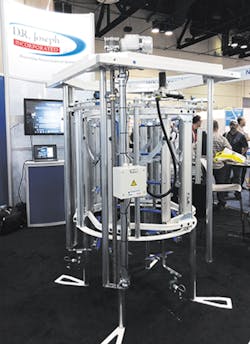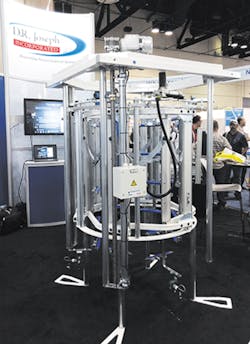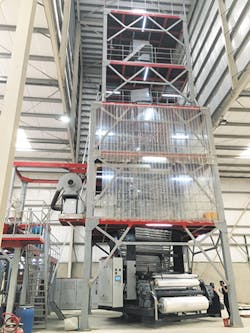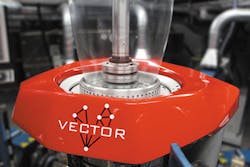Manufacturers of blown and cast film machinery at NPE2018 unveiled new and enhanced equipment for boosting production and enhancing film quality.
D.R. JOSEPH
D.R. Joseph unveiled two new blown film technologies.
The company showed a new type of radial sizing cage designed for stabilizing blown film bubbles.
Traditionally, blown film producers have had to choose between two types of diameter adjustment for the supporting arms and rollers of sizing cages: iris-style adjustment and radial adjustment. Iris-style cages typically have one pivot point to swing curved arms inward for smaller bubbles or outward for larger bubbles. Radial-style cages move rollers inward and outward perpendicularly with a scissors-like action.
While radial cages are generally considered superior, they come at a cost. They are more mechanically complex, with many more pivot points that can result in mechanical play. They also have a large footprint and a much higher price tag compared to iris-style cages, D.R. Joseph marketing manager Michael Pilolli said. However, D.R. Joseph says its new generation of radial sizing cages addresses those shortfalls.
The new design reduces the number of mechanical linkages and moving parts, eliminating play and backlash; the footprint is reduced to a size similar to iris-style cages, and the total cost investment is comparable to iris-style sizing cages.
However, the new cage offers the typical benefits of radial cages: more precise diameter adjustments to 0.5mm resolution, better stability and bubble support at all diameter ranges, extreme rigidity with zero play or backlash, and improved internal bubble cooling (IBC) control with the DRJ IBC control system. IBC sensors are placed perfectly perpendicular to the film surface at all bubble widths to ensure that ultrasonic signals are optimally sent and received to maximize control of bubble cooling.
D.R. Joseph also exhibited a new control feature for non-IBC blown film lines that can control the neck height for medium- or high-stalk blown film bubbles.
The control is a new optional feature on the company's LF-Sizer product line, which manages layflat width for non-IBC blown film lines. The control system uses an ultrasonic sensor facing the bottom of the bubble flare to measure neck height and maintain its consistency to an accuracy of plus or minus 0.25 inch. The sensor conveys information to the air-ring blower, varying its speed to control neck height. It communicates via standard serial data communications with a Yaskawa A1000, P1000 or V1000 inverter.
The new control feature also coordinates the competing tasks of managing layflat width and neck height during startup, hole recovery and normal production. Controlling and maintaining neck height on high- or medium-stalk bubbles correlates to improved consistency in the impact strength and other properties of HDPE and MDPE film while making high neck bubbles considerably easier to size and run.
ADDEX
Addex highlighted its Intensive Cooling "down-on-the-die" air ring and introduced the new Intensive Cooling Height Adjustable Twin-Stack system for blown film, which increases bubble stability and boosts production, according to the company.
Inspired by the aerodynamic forces that act on airplane wings in flight, the new Intensive Cooling systems include patent-pending cooling elements that incorporate high-velocity airflows, which actively lock and hold the bubble, company President Bob Cree said. Low-velocity airflows have traditionally been used that do not support the bubble, like an aircraft that is falling to the ground when stalled, Cree said.
The new height-adjustable Twin-Stack system optimizes performance for high- and low-melt-strength materials by offering a lower cooling element that mounts flat to the die, similar to the down-on-the-die version, and a second, height-adjustable cooling element just below the air ring. Both raised-up and down-on-the-die systems are adaptable to changes in materials and support fast changeovers.
The Intensive Cooling twin-stack elements can be separated by a range of 1 inch to 16 inches, allowing the operator to change their height to control the amount of cooling. For super-low-melt-strength materials, a short distance between the elements is ideal. For high-melt-strength materials, the cooling zone can be extended to its maximum by the push of a button. The Intensive Cooling Height-Adjustable Twin-Stack system can be fine-tuned while the line is running without time-consuming equipment changes.
With the simpler down-on-the-die version, Addex guarantees a film producer will see a production increase of 10 to 15 percent. In real-world applications, the company has seen operators achieve production increases of 20 percent to 30 percent and greater, Cree said. Some producers of high-melt-strength materials could see increases of as much as 40 percent or even 50 percent, according to the company. The amount of the increase depends largely on the types of plastics being extruded and the goals of the producer.
In comparison, the Twin-Stack system adds a second cooling element with two additional holding points, which further increases bubble stability and allows operators to boost production speed even more. The production speed increase for both systems depends on the importance of bubble stability to the producer.
"It's a trade-off between increased production rate and bubble stability," Cree said. "Some operators prefer to take the full stability improvement and see a 10 to 15 percent increase in rate, while others crank up the rate as high as possible."
Stability is particularly important for certain types of film, including nylon and oxygen-barrier films. These materials are costly, and processors want to ensure quality and avoid scrap by ensuring bubble stability. In addition, some processors have reported being able to run difficult structures that they previously were unable to run.
Intensive Cooling systems appeal both to producers primarily interested in maximizing production rates, as well as those interested in improving product quality. "This has very broad appeal," Cree said. "It not only appeals to the guys who are pushing the process, but also to those that are producing the best of the best."
Intensive Cooling systems are designed as retrofits for blown film lines.
JINMIN MACHINERY
Jinming Machinery, a Guangdong, China-based manufacturer of plastic film extrusion equipment, launched its new Ultrawide Dual Bubble Blown Film Line for heat-shrink films.
Increased demand for ultra-wide heat-shrink film led Jinming to launch a five-layer dual bubble blown film line for polyolefin shrink film. The new line has a maximum film width of 11 feet.
Jinming's three-layer polyolefin line is still available.
The new MS5R-3600Q-C five-layer line is used for high-quality film production.
Jinming has produced more than 100 polyolefin film lines worldwide since 2003. The trend for polyolefin lines is to produce films with five layers and ultra-wide widths at high production rates, according to a company statement.
Jinming incorporates internet and data monitoring technology into its equipment with the goal of making it compatible with future smart factory technology or Industry 4.0 standards, according to the company.
RBI is Jinming's representative in the U.S. and Canada.
SML
Within the past two months, SML updated its MiniCast line, designed for smaller-quantity producers of stretch film, with a new 62-inch-diameter chill roll.
The new MiniCast chill roll unit is based on the company's PowerCast chill roll unit, which was designed for larger producers of shrink wrap and was unveiled at the K show in 2016. Due to the PowerCast's enhanced performance with the large-diameter roll, SML decided to offer a similar size chill roll on its MiniCast line, which is designed for smaller and niche operations.
A conventional chill roll unit consists of a primary chill roll with a cleaning roller and a secondary chill roll fitted with a nip roller.
By contrast, the new design has one main chill roll with a diameter of 62 inches, which is the largest in the industry, according to SML. The large- diameter roll offers process benefits in terms of higher output and increased melt curtain stability at a speed comparable to using two smaller rolls, and it does so at a lower cost.
"The MiniCast with this new, large-diameter chill roll gives customers with limited amounts of capital the ability to buy a narrow machine but with higher outputs than usually are possible at such widths," Mark Jones, SML's director of support services for North America, said.
The cleaning roller is retained as a standard feature on the MiniCast chill roll unit.
The MiniCast line can produce three 20-inch wide rolls of film at a time.
BRAMPTON ENGINEERING
Brampton Engineering debuted the Vector S, an auto-gauging option for its Vector Air Ring.
President Gary Hughes said the Vector S offers a more precise level of gauge control during startup. The Vector S takes a shorter time to significantly lower the gauge variation that comes from the die and air ring. Starting gauge can be reduced in some cases by up to 80 percent.
The standard Vector Air Ring, which was introduced in 2016, features a single inlet that uniformly distributes air around the ring. The uniform airflow around the lip reduces variability of the starting gauge. Other air rings have multiple inlets.
The Vector stores set-up recipes in its memory for repeat orders. "Our customers are having shorter runs, and they want startups to be easier," Hughes said.
The Vector S option measures the thickness of the film and automatically tweaks it to more quickly achieve optimum gauge. It utilizes airflow servo-control actuators for rapid corrections without adding heat to the film.
There are 180 to 252 digital control points adjacent to the lip, which has a streamlined design to accommodate precise profile adjustments. The number of digital control points depends on the size of the air ring.
Hughes said a typical start-up time of 30 minutes can be reduced to 15 minutes with the Vector S.
Bruce Geiselman, senior staff reporter
Contact:
Addex Inc., Newark, N.Y., 315-331-7700, www.addexinc.com
Brampton Engineering Inc.,
Brampton, Ontario, 905-793-3000,www.be-ca.com
D.R. Joseph Inc.,
Arlington, Texas, 817-987-2030,www.drjosephinc.com
RBI Inc./Jinming Machinery Co. Ltd., Exeter, N.H., 603-502-9405, www.jmjj.com
SML North America Service Inc.,
Gloucester, Mass., 978-394-1553,www.sml.at
About the Author
Bruce Geiselman
Senior Staff Reporter Bruce Geiselman covers extrusion, blow molding, additive manufacturing, automation and end markets including automotive and packaging. He also writes features, including In Other Words and Problem Solved, for Plastics Machinery & Manufacturing, Plastics Recycling and The Journal of Blow Molding. He has extensive experience in daily and magazine journalism.



